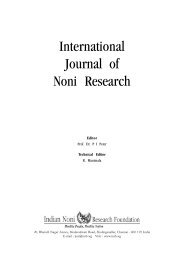International Journal of Noni Research - Noni Family
International Journal of Noni Research - Noni Family
International Journal of Noni Research - Noni Family
You also want an ePaper? Increase the reach of your titles
YUMPU automatically turns print PDFs into web optimized ePapers that Google loves.
N. Mathivanan et al. Chemical and biological properties <strong>of</strong> Morinda spp.<br />
distilled water (3.9 ml), and kept in screw cap containers under dark conditions<br />
at 40 o . To 0.1 ml <strong>of</strong> this solution, 9.7 ml <strong>of</strong> 75% ethanol and 0.1 ml <strong>of</strong> 30%<br />
ammonium thiocyanate were added. After 3 min, 0.1 ml <strong>of</strong> ferrous chloride in<br />
3.5% HCl was added to the reaction mixture and the absorbance <strong>of</strong> the red<br />
color was measured at 500 nm every 24 h, until one day after absorbance <strong>of</strong><br />
the control reached maximum. The control and standard were subjected to the<br />
same procedure as the sample except for the control, where there was no<br />
addition <strong>of</strong> sample, and for the standard 4 mg <strong>of</strong> sample were replaced with<br />
4 mg <strong>of</strong> a-tocopherol or BHT.<br />
Thiobarbituric acid (TBA) test<br />
The same samples as prepared for the FTC method were used in TBA test. To<br />
1 ml <strong>of</strong> sample solution, 2 ml each <strong>of</strong> 20% aqueous trichloroacetic acid and<br />
aqueous thiobarbituric acid were added. This mixture was then incubated in<br />
a boiling water bath for 10 min. After cooling, it was centrifuged at 3000 rpm<br />
for 20 min and the absorbance <strong>of</strong> supernatant was measured at 532 nm.<br />
Antioxidative activity was recorded based on absorbance on the final day.<br />
Antimicrobial activity<br />
The antimicrobial activity <strong>of</strong> Morinda spp. was studied using disc diffusion<br />
method for bacterial pathogens. In the case <strong>of</strong> phytopathogenic fungi, the fresh<br />
and dry weights were estimated.<br />
Determination <strong>of</strong> minimum inhibitory concentration (MIC)<br />
Among different solvent extracts, the chlor<strong>of</strong>orm fruit extract was used to<br />
determine the minimum inhibitory concentration (MIC) against different human<br />
and plant pathogens by broth dilution assay <strong>of</strong> Hammer et al. (1996) with some<br />
modifications. The nutrient broth (NB) and potato dextrose broth (PDB) were<br />
used instead <strong>of</strong> heart infusion agar and Mueller Hinton Broth (MHB) with<br />
chlor<strong>of</strong>orm fruit extract at the concentrations <strong>of</strong> 10–1000 mg/ml. The pathogens<br />
were inoculated separately and the flasks were incubated at 28 ± 2°C under<br />
shaken condition. The growth <strong>of</strong> human pathogens and mycelial weight <strong>of</strong> the<br />
plant pathogens were measured after 24 h and 5 days, respectively. Based on<br />
the growth, the MIC for each pathogen was determined.<br />
Effect <strong>of</strong> fruit extracts <strong>of</strong> Morinda spp. on respiration<br />
The effect <strong>of</strong> fruit extract <strong>of</strong> Morinda spp. on respiration in different test<br />
organisms was determined using dark type polarographic oxygen probe. About<br />
5 ml <strong>of</strong> distilled water was placed in the sample chamber and temperature<br />
controlled water circulator was used in the sample chamber to maintain 30°C.<br />
The oxygen probe was inserted into the chamber without any air bubble<br />
between the probe tip and the water surface. Magnetic stirrer was turned on<br />
Intl. J. <strong>Noni</strong> Res. 2007, 2(1-2) 64








